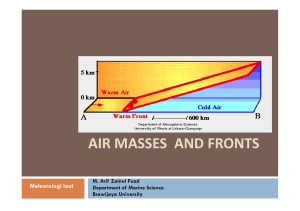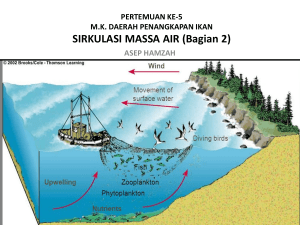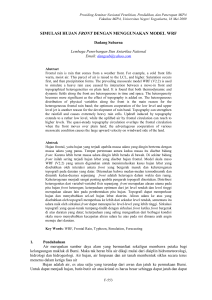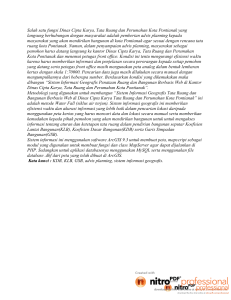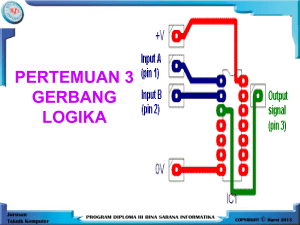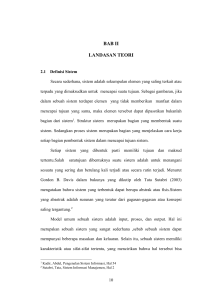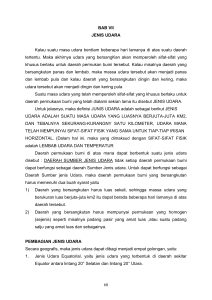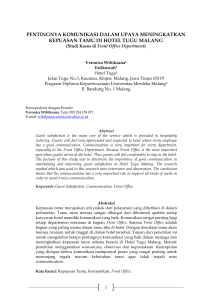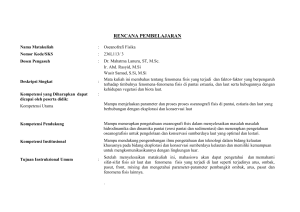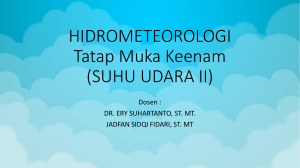UAS front - arifberbagi
advertisement
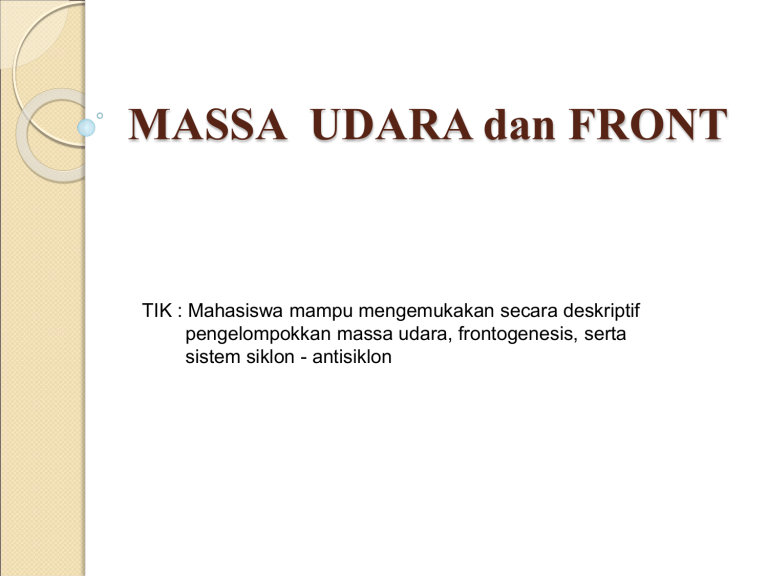
MASSA UDARA dan FRONT TIK : Mahasiswa mampu mengemukakan secara deskriptif pengelompokkan massa udara, frontogenesis, serta sistem siklon - antisiklon MASSA UDARA Massa udara : Glossary ◦ An air mass is a large body of air whose properties of temperature and humidity are fairly similar in any horizontal direction ◦ Dimensi horisontal : ratusan hingga ribuan kilometer (biasanya >1000 Km2) ◦ Dengan massa udara lainnya dibatasi oleh zona transisi yang karakteristiknya sangat berbeda • Kehomogenan badan udara : • dihasilkan oleh kontak yang lama di daerah sumber dengan permukaan yang terdapat dibawahnya yang memiliki suhu dan kelembaban seragam; pada umumnya berupa dataran (flat). • Daerah sumber : kawasan tempat terbentuknya massa udara • • Pada umumnya daerah sumber ideal adalah didominasi oleh tekanan permukaan yang tinggi, seperti : dataran arctic yang tertutup salju/es di musim dingin, lautan di subtropis pada musim panas. lintang tengah (karakteristik suhu dan kelembaban bervariasi) : bukan merupakan daerah sumber yang baik tapi merupakan zona transisi MASSA UDARA Klasifikasi : P (polar), T (Tropical), maritim (m), continental (c) Daerah sumber :4 lokasi: 1. Samudera-samudera tropis dan subtropis hangat 2. Padang pasir kontinental subtropis yang panas 3. Samudera lintang tinggi yang relatif dingin 4. Benua lintang tinggi yang sangat dingin dan kawasan es/salju MASSA UDARA Dari empat kawasan sumber terbentuk empat kelas massa udara: Maritim tropis (mT) Kontinental tropis (cT) Maritim polar (mP) Kontinental polar dan artik (cP dan cA). KARAKTERISTIK MASSA UDARA KAWASAN SUMBER POLAR (P) TROPICAL (T) LAND continental c cP cold, dry, stable cT hot, dry, stable air aloft, unstable surface air WATER Maritim m mP cold, moist, unstable mT warm, moist, usually unstable continental arctic (cA) air masses are extremely cold and dry Air mass source regions and their paths Modifikasi Massa Udara Massa udara adalah sekelompok massa yang bergerak dinamis, sehingga akan selalu bergerak dari kawasan sumber (asal terciptanya) ke lokasi yang lain. Perpindahan ini akan membawa konsekuensi terjadinya modifikasi. Modifikasi yang terjadi melalui 2 cara: (1) Terjadi pertukaran lembab dan panas (2) Menjadi stabil(turun) atau menjadi tidak stabil (udara bergerak naik). Modifikasi Massa Udara Modifikasi yang terjadi tergantung pada wilayah yang dilewati: bila wilayah yang dilewati hangat maka massa udara akan termodifikasi menjadi hangat dan dituliskan pada huruf ketiganya huruf w. Jika udara melewati lokasi yang dingin maka huruf ketiganya menjadi c. Modifikasi Massa Udara Setelah terjadinya percampuran massa udara maka udara kan mengalami dua hal menjadi tidak stabil atau stabil: sehingga huruf keempatnya menjadi u untuk unstabil dan s untuk stabil. Modifikasi Massa Udara MASSA UDARA ASAL SETELAH MELINTASI KAWASAN HASIL AKHIR mT mTw or mTc mTws or mTwu mTcs or mTcu cT cTw or cTc cTws or cTwu cTcs or cTcu mP mPw or mPc mPws or mPwu mPcs or mPcu mT mTw or mTc mTws or mTwu mTcs or mTcu Keterangan: mTwu: massa udara berasal dari maritim tropis yang melewati lokasi yang hangat (w) sehingga menjadi tidak stabil (u). Apa yang terjadi jika dua massa udara bertemu? Akan ditentukan oleh karakteristik dari kedua massa udara 1. Jika karakteristik massa udara sama………….ITCZ 2. Jika karakteristik massa udara berbeda…….Front ITCZ dan Front ITCZ merupakan singkatan dari Inter-Tropical Convergence Zones merupakan tempat bertemunya dua masssa udara yang memiliki sifat dan kekuatan yang sama. Lokasi yang identik dengan terjadinya konvergensi (naiknya massa udara) lalu tekanan udara menjadi rendah dikenal dengan istilah siklon, pada akhirnya menjadi wilayah tempat semua angin akan bergerak. Dampak yang terjadi adalah wilayah ITCZ menjadi wilayah yang bercuaca buruk akan terbentuk awan besar yang berkembang vertikal (Cumulonimbos, Cb). Sehingga terjadi hujan badai besar dengan angin dan petir. ITCZ Posisi ITCZ bulan Januari dan Juli FRONT Front didefinisikan sebagai wilayah transisi tempat bertemunya dua massa udara yang berbeda sifat fisik dan kekuatannya. Lokasi kejadian lintang tinggi sekitar 66.5o lintang utara atau selatan. Awal pembentukan, perkembangan hingga penguatan front dikenal dengan istilah FRONTOGENESIS What is an atmospheric front? A front is a transition zone between two air masses of different densities. The density contrast results from: ◦ Difference in temperature; ◦ Difference in humidity. The frontal zone (surface) is the upward extension of the front. Sometimes the frontal zones can be very sharp. The intensity of the weather along the front depends on the contrast of the air mass properties. The type of front depends on both the direction in which the air mass is moving and the characteristics of the air mass. FRONT Pada kondisi normal (a) dan tingkat pembentukan front (b) FRONT Sedangkan fase akhir pelenyapan atau penghancuran front dikenal sebagai FRONTOLISIS. Front sama halnya dengan ITCZ merupakan siklon (pusat tekanan rendah) sehingga cuaca buruk. Gambar sebaran suhu ke arah tegak di dalam daerah front dapat dilihat pada Gambar merupakan indikator front adanya perbedaan suhu yang tajam sepanjang front. FRONT Distribusi suhu pada penampang melintang front JENIS-JENIS FRONT Berdasarkan hasil akhir dari pertempuran dua massa udara, mana yang menjadi dominan akan dijadikan nama dari front tersebut: (1). Front dingin: massa udara dingin menggilas massa udara panas (2). Front panas: massa udara panas mendesak massa udara dingin (3). Front campuran: front dingin dan front panas bertemu sehingga front dingin akan lebih cepat mengambil alih lokasi front panas. (4). Front quasi stasioner: apabila dua massa udara baik dingin mapun panas masing-masing tidak cukup kuat untuk saling mendesak, sehingga tidak jelas mana yang mendominasi. (5). Siklon frontal: adalah siklon ekstratropis yang mengandung sistem frontal. Cold Fronts Associated with low pressure centers (low pressure troughs): follow the dashed line The pressure is minimum as the front passes (first decreases as the front approaches and then increases behind the front) Steep leading edge: the vertical slope of a cold front surface is 1:50 - 1:100 (ratio of vertical rise to horizontal distance). For comparison: warm fronts have ratios 1:200 – 1:300. The steeper the edge, the faster the front (the effect of surface friction). Cold fronts tend to move faster than all other types of fronts. Cold fronts tend to be associated with the most violent weather among all types of fronts. Cold fronts tend to move the farthest while maintaining their intensity. Cirrus clouds well ahead of the front Strong thunderstorms with heavy showers and gusty winds along and ahead of the front: squall lines Broad area of cumulus clouds immediately behind the front (although fast moving fronts may be mostly clear behind the front). Characteristics of a Warm Front The slope of a typical warm front is 1:200 (more gentle than cold fronts) -> warm fronts tend to advance more slowly. Warm fronts are typically less violent than cold fronts. Overrunning: warmer, less-dense air rides up and over the colder, more-dense surface air. Frontal inversion: temperature inversion at the front -> stable atmosphere Warm Fronts: cloud and precipitation patterns Although they can trigger thunderstorms, warm fronts are more likely to be associated with large regions of stratus clouds and light to moderate continuous rain. Warm fronts are usually preceded by cirrus first, then altostratus or altocumulus, then stratus and possibly fog. At the warm front, gradual transition. Behind the warm front, skies are relatively clear. The weather during a WARM FRONT starts with cirrus clouds about 24-48 hours before the rain begins 2. As more warm air is pushed upward, more moisture condenses forming cirrostratus clouds 3. Warm front: rain or snow is steady over several hours or days 1. Occluded fronts. Cold fronts move faster than warm fronts. They can catch up and overtake their related warm front. When they do, an occluded front is formed. Cold occlusion: very cold air behind, not so cold air ahead of, the warm front The upper warm front follows the surface occluded front Cold occlusion Warm Occlusion Very cold air ahead of, not so cold air behind, the warm front The cooler air from the cold front cannot lift the very cold air ahead, rides “piggyback” The warm front aloft precedes the surface occluded front Stationary Front Stationary front- a front which does not move or barely moves. Stationary fronts behave like warm fronts, but are more quiescent. Many times the winds on both sides of a stationary front are parallel to the front and have opposite direction. Typically stationary fronts form when polar air masses are modified significantly so as to lose their character (e.g., cold fronts which stall). Typically there is no strong precipitation associated with stationary fronts (why? – no big contrast in the air mass properties, no air uplifting and condensation). Weakening/Strengthening of the Front • Frontolysis: ♦ The front weakens and dissipates ♦ Why?-the air masses start losing their identities. ♦ The temperature (humidity) contrast across the front is decreasing. ♦ Typical for slow moving fronts Frontogenesis: ◦ The front intensifies. ◦ Why? – The temperature (humidity) contrast across the front is increasing. ◦ Example: cP air mass moves over warm ocean water. Clouds and Fronts - Example Peta cuaca Shown: surface-pressure systems, air masses, fronts, isobars, winds and air flow (large arrows) Green-shaded area: precipitation EXAMPLE Depressions (L) over Europe showing FRONTS Pressure Systems There are two types of pressure systems: Highs and Lows H L A “high,”or anticyclone, is an area of high pressure around which the winds blow clockwise in the northern hemisphere (counterclockwise in the southern hemisphere.) High pressure is associated with sinking, more dense air. A “low,”or cyclone, is an area of low pressure around which the winds blow counterclockwise in the northern hemisphere (clockwise in the southern hemisphere.) Low pressure is associated with rising, less dense air. High pressure is normally associated with “good” weather: • Clear or clearing skies, no precipitation, light winds (away from terrain effects). Low pressure is normally associated with “unsettled” weather: • Cloudy skies, precipitation, gusty winds. Pressure Systems: Isobars Wind barbs define wind direction and speed on a synoptic chart... 20 16 12 04 24 H 1025 08 00 96 L 994 …and also help define frontal boundaries Perbedaan Siklon & Antisiklon ANTI SIKLON SIKLON Pusat tekanan udara tinggi semi permanen, simbol HTerbentuk di suatu wilayah yang sedang berlangsung musim winter. Pola angin divergen (massa udara turun). Cuaca cerah, sulit terbentuk awan sehingga jarang hujan Pusat tekanan udara rendah semi permanen, simbol LTerbentuk di suatu wilayah yang sedang berlangsung musim summerPola angin konvergen (massa udara naik)Cuaca berkabut, Terbentuk awanawan berpotensi sebagai hujan Bila terjadi polusi udara akan terperangkap di dekat permukaan contoh kejadian di Kota London Desember 1952, sebanyak 5.000 penduduk tewas karena polutan. Akibat gaya coriolis badai tropis dengan angin 60 km/jam, siklon trpois > 120 km/jam (Hurricane, Typhoon), dilaut kecepatan angin > 250 km/jam. Contoh di Banglades Nop 1970, sebanyak 20.000 penduduk tewas diterjang siklon tropis. Pusat antisiklon tetap: -23.5oLU/LS di darat pada wilayah gurun dan di laut pada lintang kuda -90oKU/KS dingin dan kering Pusat siklon tetap:-di equator 0o: ITCZ -di 66.5oLU/LS BAHAN UTS Sumber bacaan : 1. Stull RB. 2002. Meteorology for scientist and engineer. Terutama Bab Radiasi 2. Ahrens DC. Meteorology Today atau Essentials of meteorology 3. Bahan kuliah (power point) 4. SELAMAT UJIAN………….SEMOGA SUKSES
